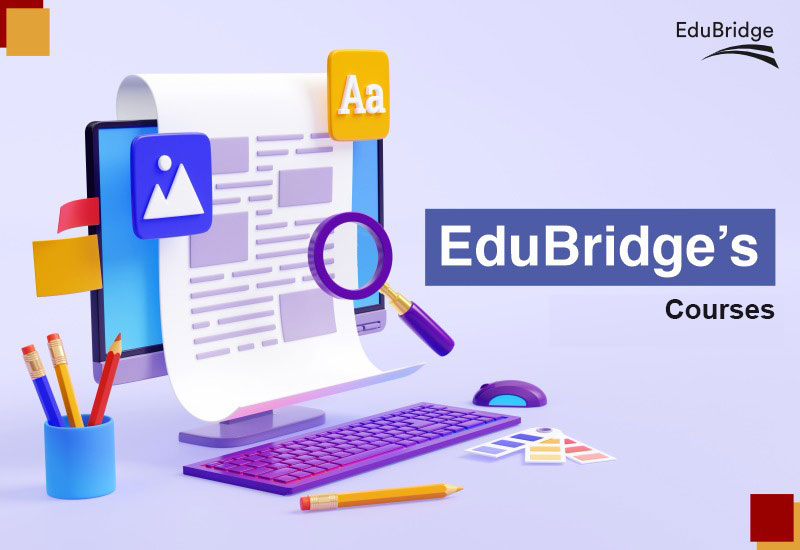Subscribe
Subscribe to EduBridge Blogs
Full Stack Java Developer Roadmap An Introduction
Java, a robust and widely used programming language, holds a prominent position in the tech world. Ranked 2nd and 3rd on The PYPL Index (2022), Java and JavaScript have solidified their place among the top 10 programming languages globally.
With such popularity, embracing the path of a Full Stack Java Developer in 2023 is an intelligent career move. By following this Java full stack developer roadmap and gaining practical experience, you can unlock endless possibilities in the world of full-stack Java development and establish yourself as a versatile professional.

Full Stack Java Developer Roadmap for Freshers
As a full-stack Java developer, you should have knowledge of front-end, and back-end technologies, databases, and a wide range of Java tools, enabling you to develop comprehensive software solutions from end to end. Apart from this here’s, the full-stack Java developer roadmap if you are a fresher:
- Fundamentals of Java are a must: Knowledge, skills and functionality of the core concepts of Java, syntax, data types, control flow and object-oriented programming principles. Building a strong foundation in Java is a must. It is the core aspect in the roadmap for full stack java developer
- Basics of Web Development: Gain in-depth understanding and knowledge of HTML, CSS, and JavaScript. Learn how to create static web pages and familiarize yourself with the fundamentals of front-end development (client-side server). To gain a basic understanding of HTML, check out our free course from EduBridge here
Also, if you are keen to learn about CSS, check out our free course here - Back-end Development: Learn about server-side development using Java frameworks such as Spring Boot or Jakarta EE. Learn about database management, RESTful APIs, and server-side scripting. Gain hands-on experience in building robust back-end systems for seamless usage of the front-end sites. Both front-end and back-end technologies are extremely crucial for the roadmap for full-stack Java developers.
- Front-end development: Enhance your skills in front-end development by learning popular JavaScript frameworks like Angular, React, or Vue.js. Understand component-based architectures, state management, and routing. One of the key components in the roadmap for Java full stack developer.
- Database Management: Learn SQL for querying and managing relational databases. Gain experience in integrating databases with Java applications using ORMs like Hibernate or JPA. Here’s a step-by-step guide for MySQL from EduBridge.
- Version Control: Learn to use Git for version control. Understand concepts like branching, merging and resolving conflicts. Also, learn to collaborate with other developers using platforms like GitHub and GitLab.
- Deployment and DevOps: Explore the deployment of Java applications on servers or cloud platforms like AWS or Azure. Understand containerization using tools like Docker and container orchestration with Kubernetes. Familiarize yourself with CI/CD pipelines.
- Testing: Learn about different testing methodologies and frameworks like JUnit for writing unit tests. Gain experience in integration testing and end-to-end testing. Understand the importance of testing in ensuring software quality.
- Security: Gain knowledge of secure coding practices and techniques to mitigate common web vulnerabilities. Understand authentication and authorization mechanisms. Learn about security best practices for Java applications.
- Continuous Learning: Stay updated with the latest advancements in Java and related technologies. Explore new frameworks, tools, and industry trends. Engage in online communities, attend meetups, and pursue relevant certifications to expand your knowledge.
Full Stack Java Developer Roadmap for experience
As an experienced professional in the field, take your career to new heights with our comprehensive roadmap for full stack Java developer. From mastering front-end frameworks and back-end technologies to honing your architectural expertise and deployment strategies, our full stack Java developer roadmap will guide you towards becoming a pro.
- Strengthen Core Java and Java Frameworks: Deepen your understanding of core Java concepts, including object-oriented programming, data structures, and algorithms and become a pro in Java. Master popular Java Frameworks for building robust and scalable applications using Spring, Hibernate and JavaServer Faces (JSF).
- Front-end Development: Acquire proficiency in front-end technologies like HTML, CSS and JavaScript. Familiarize yourself with popular front-end frameworks such as Angular or React.
- Database Management and RESTful API Development: Gain expertise in working with databases including SQL and NoSQL databases like MySQL, Oracle, MongoDB, or PostgreSQL. Learn how to design and implement RESTful APIs using frameworks like Spring Boot, JAX-RS, or Jersey.
- Cloud Technologies: Familiarize yourself with cloud platforms like AWS, Azure, or Google Cloud to deploy and manage applications in a scalable and cost-effective manner.
- DevOps and CI/CD: Understand the principles of DevOps and Continuous Integration/Continuous Deployment (CI/CD). Learn tools like Git, Jenkins, and Docker for efficient development and deployment processes.
- Testing and Quality Assurance: Acquire knowledge of testing frameworks such as JUnit and Mockito for unit testing, as well as automated testing tools like Selenium for UI testing.
- Security best practices and stay updated: Understand security concepts and implement secure coding practices to protect applications from common vulnerabilities and attacks. Continuously expand your knowledge by staying up to date with the latest trends, frameworks, and technologies in Java.
An Overview of Front-end Module 2023
In the Java full stack developer roadmap let’s delve into the front-end module, one of the vital aspects for the developers. It focuses on the user interface and interactivity of web applications. Explore the key components and technologies, empowering you with the knowledge needed to create engaging and responsive front-end experiences.
- JavaScript
JavaScript is considered to be one of the popular programming languages. JavaScript is a scripting language used on the client side to give life to web pages. It is a must to know if you want to become a Java developer. From Ads to pop-ups to asynchronous calls, everything is handled by JavaScript.
- ReactJS
ReactJs is an open-source JavaScript front-end library for creating dynamic and interactive applications improving UI/UX design. ReactJS uses JSX as its coding style that is mixed with HTML quotes and tag syntax to develop the components. With Frameworks such as Next.js, React can be utilized for developing single-page, mobile or server-side applications allowing code to be debugged more efficiently and effectively by separating it into components.
- Angular.js
Angular.js is an integral part of the MEAN stack i.e. MongoDB, Express.js, Angular and Node.js. Developing single-page web applications becomes easy due to Angular.js. It provides fast loading and less navigation, ensuring the user experience is effective. Due to its flexible framework, developers can create progressive web apps or integrate the framework technologies like Ionic, Cordova or NativeScripy to design near-native mobile applications.
- Vue.js
Vue.js is a highly popular JavaScript framework renowned for its ability to create lightweight and adaptable interactive UI elements. With its MVVM (Model-View-ViewModel) architecture pattern and lightweight nature, Vue.js offers developers an easy-to-implement solution. Knowledge of HTML and CSS is essential to utilize Vue.js effectively. Its core library is primarily focused on the view layer, allowing seamless integration into larger projects without any compatibility issues.
- Flutter
Flutter is popular because of its ability to leverage native capabilities and create expressive elements on both iOS and Android platforms. It enables developers to create cross-platform apps quickly using the Dart programming language and Skia graphical engine and easy for developers to create apps fast using Flutter-Dart.
- Bootstrap
Bootstrap is a free, open-source framework designed to create mobile-friendly, responsive, websites and applications. It includes CSS and JavaScript templates for typography, navigation, buttons, forms and other important UI elements/components. HTML, CSS and JavaScript tools are included in the Bootstrap toolkit to create front-end design elements of responsive websites quickly and easily.
- PWAs
PWAs is an acronym for progressive web applications. PWAs provide a native app experience to the users through the browser itself like offline functionality, push notifications, easy updates, discoverability and likability and smooth performance. PWAs are often released as “Lite” versions on the play store and do not exceed more than 1 MB in size. It looks like a native app but opens in a browser inside to view the items. PWAs work best even in low network connections. It provides a cost-effective solution for businesses to reach a wider audience without the barriers of app stores.
- CSS frameworks
CSS frameworks such as Bootstrap, Foundation, and Materialize are valuable tools for full-stack Java developers engaged in front-end development. These frameworks offer a collection of pre-designed UI components, responsive layouts, and ready-to-use styles that significantly expedite the development process. By leveraging the power of CSS frameworks, developers can quickly create visually appealing and consistent user interfaces across different devices and browsers.
- Responsive and Mobile-first Design
With the increasing usage of mobile devices, front-end developers prioritize responsive and mobile-first design. The websites and applications created adapt seamlessly to different screen sizes, ensuring optimal user experience across desktops, tablets and smartphones. This improves user experience and readability, reaches a wider audience, enhances SEO performance, etc.
- Component-based Development
Component-based development is a method of developing software that deals with the design and development of reusable components to build modular and scalable applications, improving development efficiency and code maintainability. Component-based architecture is constantly updated- without having to rebuild it from the starch. Hence, component-based design is a perfect choice for organizations with large, rigid, source code.
- WebAssembly (Wasm)
WebAssembly is a binary instruction format that enables running high-performance code in web browsers. It allows developers to write code in low-level languages like C, C++ and Rust which are known for their performance characteristics, hence Wasm seems to be faster than JavaScript. Wasm is used by front-end developers for tasks like gaming, video editing, data processing, etc. directly in the browser.
- Design Systems and UI Libraries:
Front-end developers utilize design systems and UI libraries to ensure consistency and streamline development. The tools provide pre-built UI components, typography guidelines and design patterns facilitating faster and more cohesive front-end development.
- Accessibility and Inclusive Design
To ensure that websites and applications are usable by people with disabilities, front-end developers prioritize accessibility and inclusive design. They follow WCAG (Web Content Accessibility Guidelines) and implement accessibility features like keyboard navigation, alt text for images and proper semantic markup.
- Web Performance Optimization
Improving website performance and loading times remain crucial. Front-end developers optimize assets, leverage caching techniques and adopt lazy loading and code-splitting strategies to deliver fast and responsive web experiences.
- Integration with Backend and APIs
Front-end developers work closely with backend teams to integrate their modules with server-side logic and APIs. They leverage RESTful and GraphQL APIs to fetch and update data, enabling dynamic and interactive experiences.
For more details about the skills required for becoming a Java Full Stack Developer in 2023, check this out.

An Overview of Back End Module 2023
In this Java full stack developer roadmap, we shall get a comprehensive overview of the back-end module another essential aspect of becoming a Java full stack developer. The back-end module handles the server-side logic, data management, and integration with databases and external systems. Gain insights into the key components and technologies involved, equipping you to build robust and scalable back-end solutions.
- Java
Java is a widely used programming language for back-end development. It provides a robust and scalable environment for building enterprise-level applications. For websites that generate a lot of traffic, Java works the best since it can handle the traffic.
- Spring Framework
The Spring Framework is a popular Java framework that simplifies the development of Java applications. Being an open-source framework for building enterprise Java applications, it offers features like dependency injection, aspect-oriented programming, and support for various modules like Spring MVC (Model-View-Controller) for building web applications.
- RESTful APIs
REST is an abbreviation of Representational State Transfer (REST) which is an architectural style used for designing networked applications. RESTful APIs provide a standardized way of communication between the front end and back end. In Java, it enables the development of scalable and interoperable web services by leveraging the HTTP protocol and standardized principles. Full-stack Java developers work with frameworks like Spring Boot to create RESTful APIs. RESTful APIs use HTTP methods (GET, POST, PUT, DELETE) to perform operations on resources (data).
- Databases
Relational databases like MySQL, PostgreSQL, or Oracle, and NoSQL databases like MongoDB or Redis, are commonly used in back-end development. A full-stack Java developer needs to understand database concepts, design data schemas, and write SQL queries to interact with databases effectively. This involves carefully defining tables, relationships, and indexes to minimize redundancy and ensure data integrity.
Furthermore, proficiency in writing SQL queries is essential for extracting, updating, and manipulating data in relational databases. It involves utilizing SQL statements such as SELECT, INSERT, UPDATE, DELETE, and JOIN to retrieve specific data, perform aggregations, and modify the database content.
- ORM Frameworks
Object-Relational Mapping (ORM) frameworks like Hibernate or JPA (Java Persistence API) simplify database interactions by mapping database tables to Java objects. These frameworks automate the tedious and error-prone task of manually writing SQL queries and handling the conversion of data between the object-oriented and relational paradigms. By utilizing Hibernate or JPA, Java developers can focus on the business logic of their applications rather than dealing with low-level database operations.
- JUnit and Mockito:
JUnit and Mockito are essential tools in the arsenal of a full stack Java developer. JUnit is a popular testing framework that enables the creation and execution of unit tests for Java applications. It provides a standardized approach to writing tests, asserting expected results, and identifying failures. Mockito, on the other hand, is a mocking framework that simplifies the testing of individual components by creating mock objects that mimic the behaviour of real dependencies. This allows developers to isolate the code being tested and focus on specific scenarios. Mastery of JUnit and Mockito empowers developers to write comprehensive unit tests that verify functionality, enhance code quality, and improve the overall reliability of their back-end systems.
- Caching
Caching mechanisms like Redis or Ehcache can be employed to improve the performance of your application. Caching frequently accessed data or query results can reduce database hits and enhance response times. Caching can be implemented at different levels, including client-side caching, server-side caching, and database caching. In client-side caching, web browsers or mobile apps store static resources like HTML, CSS, and JavaScript files in the browser cache, reducing the need to fetch them from the server repeatedly. Server-side caching involves caching responses from the backend, such as API responses, database query results, or rendered web pages. This helps minimize the load on the server and improves response times. Database caching, using tools like Redis or Memcached, stores frequently accessed data in memory to avoid repeated database queries.
Brushup your Full Stack Java Developer Skills
Becoming a Java expert requires a dedicated commitment to regular practice, hands-on experience, and continuous learning. By enrolling in the Advanced Certification Program in Java Full Stack Development (with 110% Job Guarantee) offered by EduBridge, you gain a unique opportunity to optimize your learning journey and unlock your potential. Let’s embark on a code-driven adventure and build a future where “Java” is not just a programming language but a way of life!
Recent Blogs
Related Blogs
Accelerate Your Career with Expert Guidance and Guaranteed Job*!
"*" indicates required fields




